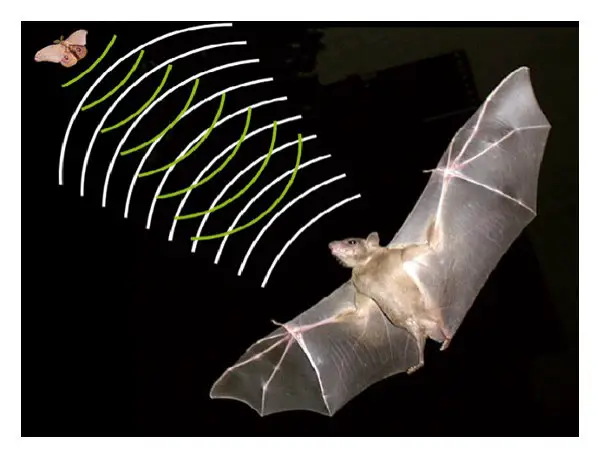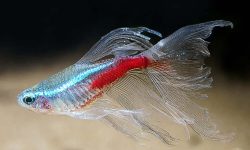Vampire bats have fascinated scientists and storytellers for centuries. These nocturnal creatures are the only mammals that feed exclusively on blood, a behavior known as hematophagy. While the idea of bats feeding on blood may seem like the stuff of horror movies, in reality, vampire bats are highly specialized animals with extraordinary adaptations that allow them to find and feed on warm-blooded hosts without being detected. Two of the most remarkable tools in their hunting arsenal are thermal imaging and echolocation—a combination that allows them to locate prey in complete darkness with astonishing accuracy.
This article dives deep into the fascinating world of vampire bats, exploring how they use thermal detection and echolocation in tandem to survive, thrive, and maintain their place in the ecosystem.

The Vampire Bat: Nature’s Nighttime Predator
The Three Species of Vampire Bats
There are three known species of vampire bats: the common vampire bat (Desmodus rotundus), the hairy-legged vampire bat (Diphylla ecaudata), and the white-winged vampire bat (Diaemus youngi). All three are found exclusively in the Americas, ranging from Mexico to Argentina, and each has evolved unique behaviors and preferences suited to its ecological niche.
The common vampire bat is the most widespread and studied of the three. It primarily feeds on the blood of mammals, especially livestock like cows, pigs, and horses. This species is highly social, often sharing regurgitated blood with roost mates in a remarkable display of food-sharing and social bonding.
In contrast, the hairy-legged vampire bat and the white-winged vampire bat tend to specialize in avian prey. These bats have developed a preference for roosting in more remote forest habitats where bird colonies are abundant. The white-winged species, for example, is more solitary and has a shorter, more delicate snout, an adaptation believed to aid in feeding on birds without waking them.
Despite their differences in prey, all three species rely on stealth and sensory precision. They approach their host quietly, often landing nearby and crawling on all fours before making a small, painless incision with razor-sharp incisors.
Evolutionary Adaptations to a Blood-Based Diet
Feeding exclusively on blood—known as hematophagy—requires extraordinary physiological and anatomical adaptations. Unlike other carnivorous or insectivorous bats, vampire bats must contend with blood’s unique properties: it is low in energy-rich nutrients like carbohydrates and fats, yet high in iron and fluid content.
To survive on such a diet, vampire bats have developed a series of remarkable evolutionary traits:
-
Efficient Fluid Regulation: Because blood is over 90% water, vampire bats must quickly eliminate excess fluid to avoid becoming bloated and grounded during flight. Their kidneys are highly specialized for this task, allowing them to excrete large volumes of dilute urine within minutes of feeding.
-
Anticoagulant Saliva: Vampire bats produce a special enzyme in their saliva called draculin, which prevents the blood from clotting at the wound site. This ensures a continuous flow of blood during feeding. Scientists have even studied this compound for potential use in treating strokes and blood clots in humans.
-
Heat and Blood Detection: Perhaps their most iconic adaptation is their infrared sensing ability. Vampire bats can detect minute heat differences on the surface of a host’s skin, allowing them to locate blood vessels even in complete darkness. This is achieved through specialized nerve endings on their noses—an ability previously thought to be exclusive to some snakes.
-
Silent Movement and Precision Cutting: Their teeth are not just sharp—they are ultra-thin and grow continuously like rodent incisors, compensating for wear from slicing tough skin. The incisions they make are so fine that the host often doesn’t notice the wound until much later. Their movements are also stealthy: vampire bats can crawl using a bounding gait similar to quadrupeds, enabling them to navigate around their prey undetected.
These evolutionary innovations have enabled vampire bats to become one of nature’s most specialized and efficient nocturnal predators. Their feeding strategy, while grotesque to some, is a masterclass in biological adaptation—balancing stealth, precision, and survival in the dark.
Echolocation: The Art of Navigating Through Sound
What Is Echolocation?
Echolocation is a sophisticated form of biological sonar used by various nocturnal and subterranean animals, including most species of bats, dolphins, and some birds like oilbirds. The process begins when the animal emits a series of high-frequency sound pulses—often beyond the range of human hearing. These sound waves travel through the air until they strike an object and reflect back in the form of echoes. By interpreting the time delay, frequency shift, and intensity of these returning echoes, the animal constructs a dynamic and detailed mental map of its surroundings in complete darkness.
In bats, echolocation is not just about detecting objects—it can also reveal texture, movement, and shape. This ability allows bats to distinguish between flying insects, leaves, and even small gaps in dense foliage. For insectivorous species, echolocation is vital for detecting, tracking, and capturing prey mid-flight with astounding precision.
How Vampire Bats Use Echolocation
Vampire bats (Desmodus rotundus and relatives) have inherited the echolocation system common to many of their bat cousins, but with a different emphasis. Unlike bats that feed on fast-moving insects and must rely on continuous, high-resolution echolocation to track and intercept prey mid-air, vampire bats use echolocation primarily for spatial navigation and orientation within complex environments.
They emit low-intensity, high-frequency calls through their mouths or noses while flying. These calls are often of a lower intensity compared to insectivorous species—likely an adaptation to avoid alerting potential hosts. The echoes that return help them detect environmental features such as:
-
Tree branches and trunks
-
Cave or barn walls and ceilings
-
Animal enclosures and fences
-
Openings like windows or entry holes in barns
This capability is especially important because vampire bats are known to enter human-made structures to feed on livestock. Their ability to navigate seamlessly in cluttered, dark environments such as barns, attics, or dense forest canopies is a testament to how finely tuned their echolocation system is to detect structure and form.
Echolocation vs. Prey Detection: A Shift in Sensory Prioritization
For vampire bats, echolocation is not the primary method for locating prey. Once they are within range of a potential host, they switch to using other senses that are better suited to the task of blood-feeding:
-
Thermoreception: Vampire bats possess specialized nerve cells in their noses capable of detecting infrared radiation. This allows them to sense warm areas on a host’s body—usually where blood vessels are close to the surface, like around the ears or limbs.
-
Olfaction and Hearing: Some studies suggest vampire bats may also use scent cues and the low-frequency sounds of breathing or movement to identify sleeping animals in the dark.
-
Memory and Social Learning: These bats remember the location of successful feeding sites and often return to the same animals night after night. They can also learn from roost mates which hosts are productive, reinforcing a collective understanding of local prey.
Echolocation, then, plays a supporting but indispensable role: it gets the bat safely to the general area of a potential host, helps it land silently, and avoid obstacles. After that, a different suite of sensory systems takes over for the final stages of predation.
The Power of Thermal Imaging: Seeing Heat in the Dark
What Is Thermal Imaging in Biology?
In technological terms, thermal imaging involves detecting infrared (IR) radiation, a form of light emitted by objects based on their temperature. Warmer objects emit more infrared radiation, which can be captured by IR sensors to form an image based on heat differences. In biology, thermoreception—the ability to sense heat—is a rare but remarkable adaptation.
Among mammals, only a few species possess true infrared sensitivity. Vampire bats (Desmodus rotundus) are one of the few exceptions. They have evolved a unique form of biological thermal imaging, allowing them to detect the faint warmth of blood vessels beneath the skin of their prey in total darkness.
Specialized Nerve Structures
The biological basis for this ability lies in the bat’s facial anatomy, specifically the nose-leaf—a fleshy, leaf-like structure located around the nostrils. While the nose-leaf in most bat species helps focus echolocation calls, in vampire bats it serves an additional role: detecting heat.
Recent neurobiological studies have revealed that vampire bats possess a high density of infrared-sensitive nerve endings in the nose-leaf, which are connected to TRPV1-like ion channels. These are specialized thermoreceptors that can detect temperature changes as small as 0.001°C. These sensory channels are similar to those found in pit vipers and boas, reptiles known for their heat-detecting capabilities.
What makes vampire bats even more fascinating is that their brain’s somatosensory cortex has a dedicated region for processing thermal information, effectively giving them a sixth sense. The area of the brain responsible for interpreting temperature signals is disproportionately large relative to body size, suggesting the importance of heat detection in their hunting strategy.
Thermoreception and Targeting Blood Vessels
Once the vampire bat has located a host animal—often using echolocation and scent—it begins scanning the host’s body for heat signatures. Using its thermal-sensing snout, it can distinguish between cooler, insulated parts of the body and warmer regions where blood flows near the surface.
These high-priority feeding zones are often:
-
Behind the ears
-
Around the groin or inner thighs
-
Along the back or shoulder blades
-
Near the legs or neck
The bat then approaches silently, landing near the chosen site. Using its razor-sharp incisors, it makes a small, V-shaped incision. The combination of stealth, precision, and sensory targeting means that the host is rarely awakened during the process.
Importantly, vampire bats do not “suck” blood—they lap it up with their tongue, aided by a groove that channels the blood and enzymes in their saliva (like draculin) that prevent clotting. But none of this would be possible without first identifying the perfect site through thermal imaging.
A Rare and Refined Evolutionary Trait
Thermal imaging in vampire bats is not only a rare trait among mammals—it is a highly specialized adaptation to their exclusive blood-based diet. Unlike other predators that rely on vision or movement to locate prey, vampire bats exploit a physiological property shared by all warm-blooded animals: body heat.
This form of hunting, rooted in the detection of passive thermal radiation, represents one of the most elegant examples of evolutionary specialization in the animal kingdom. While other bats rely on sound, and some predators rely on sight, vampire bats have developed the uncanny ability to see with heat, turning the invisible into the visible.
Coordinating Echolocation and Thermoreception
Sequential Sensory Use
Vampire bats are masters of multi-sensory integration, relying on a step-by-step deployment of different sensory systems to locate and feed on their prey. This sequential sensory use enhances both precision and stealth in the dark.
The process typically begins with echolocation, which allows the bat to navigate through complex environments like forests, caves, or barns. Using low-intensity, high-frequency calls, it maps out structures, avoids obstacles, and homes in on the general area where a host animal is present—often a sleeping bird or mammal.
Once the bat is in close proximity, echolocation is gradually de-emphasized, and thermoreception takes over. Through its specialized nose-leaf, the bat scans the host’s surface for warm zones—areas where blood vessels are closest to the skin. This layered transition between senses allows the bat to move from general orientation to high-resolution targeting, conserving energy while reducing the chances of disturbing the host.
This sensory handoff—from echolocation to thermal detection—is not just efficient; it’s essential. It ensures that vampire bats land precisely, identify the ideal incision site quickly, and feed with minimal disturbance to the host.
Tactile Feedback and Fine Motor Control
After the bat has located the optimal feeding site through thermal imaging, a third layer of sensory input comes into play: touch.
The snout and lips of vampire bats are rich in mechanoreceptors, giving them acute tactile sensitivity. These fine-tuned sensors allow the bat to feel subtle contours and temperature gradients on the skin surface, confirming the presence of a blood vessel before committing to a bite.
Once contact is made, the bat uses its razor-sharp upper incisors to create a small incision—typically less than 5 millimeters across. The wound is precise and painless, aided by the bat’s ability to regulate the pressure and angle of its bite with exquisite motor control.
Feeding itself is an act of both mechanical finesse and biochemical ingenuity. Instead of sucking, the bat laps up the oozing blood using its grooved tongue, which functions like a capillary tube. Meanwhile, anti-coagulant proteins in its saliva—particularly draculin—ensure that the blood continues to flow freely by inhibiting clotting.
Throughout the feeding process, the bat remains highly aware of its posture, contact points, and auditory surroundings. If the host stirs or another predator approaches, the bat can disengage in seconds and fly off, often returning to the same animal on subsequent nights.
The Brain Behind the Bite: Neural Integration of Sensory Inputs
Enlarged Brain Regions for Sensory Processing
Vampire bats (Desmodus rotundus) possess a brain uniquely wired to handle their complex feeding behavior. Unlike many mammals that depend heavily on vision, vampire bats rely on a triad of sensory systems—auditory, thermal, and tactile—all of which require rapid processing and coordination. To support this, certain brain regions in vampire bats are enlarged and highly specialized for sensory integration.
One key area is the inferior colliculus, a midbrain structure central to processing auditory information. In echolocating bats, this region is hyper-developed, acting as a real-time analyzer for incoming echoes. It helps the bat determine the direction, distance, and texture of obstacles and surfaces, guiding it safely through dark, cluttered environments.
Equally important is the trigeminal sensory system, which includes the infrared-sensitive nerve endings in the nose-leaf. This network feeds thermal data into the somatosensory cortex, where specialized regions map out minute differences in temperature on the host’s body. Studies using neural imaging have shown that vampire bats dedicate significantly more cortical space to heat detection than non-hematophagous bats, underlining the evolutionary importance of thermal sensing in their lifestyle.
Together, these systems don’t operate in isolation—they interact fluidly, with information from each sensory stream being rapidly integrated to form a multimodal perception of the environment. This allows the bat to make fast, high-stakes decisions during flight and feeding with remarkable precision.
Cognitive Mapping and Decision-Making
But vampire bats are not just reactive organisms—they are strategic, learning-based foragers. Their brains also house neural circuits involved in spatial memory, individual recognition, and decision-making, enabling them to optimize their nightly hunts.
Through repeated experience, vampire bats develop cognitive maps of their environment, including the location of barns, roosts, and host animals. They can recall which animals were productive feeding sites and often return to the same individual night after night. This behavior has been confirmed through studies where bats tagged with radio transmitters were observed returning to specific livestock across multiple nights, even after long foraging flights.
Moreover, they exhibit social learning—young bats can learn from older individuals which hosts are safest or most productive. This reduces the energy cost and risk associated with trial-and-error feeding. Combined with their social memory, which includes the ability to recognize and share food with specific roost-mates, vampire bats demonstrate a level of cognitive sophistication rare among mammals of their size.
In short, the brain of a vampire bat is not just a processor of sensory input—it is a coordinator, memory bank, and decision-maker that underlies the animal’s extraordinary ability to navigate, hunt, and survive in darkness.
Unique Hunting Behavior and Feeding Strategies
Social Hunting and Grooming
Vampire bats are not solitary hunters. In fact, their complex social behavior sets them apart from many other bat species. While each bat typically forages alone, there is strong evidence that they share information about feeding opportunities within their social group. Bats that successfully locate a food source may inadvertently signal others through vocalizations or scent, leading to multiple individuals feeding on the same host—though at different sites to avoid conflict.
One of the most remarkable aspects of their social life is food sharing through regurgitation. If a bat fails to feed during the night, it risks starvation—going more than 48–72 hours without a blood meal can be fatal. In such cases, another bat—often a close relative or frequent grooming partner—will voluntarily regurgitate a small amount of ingested blood to help the hungry bat survive. This behavior, known as reciprocal altruism, is rare in the animal kingdom and particularly striking among mammals.
Over time, these bats form strong social bonds, reinforced through mutual grooming and food exchange. Studies have shown that individuals remember who shared food with them and are more likely to reciprocate in the future, indicating a form of long-term cooperative memory.
Stealth and Silent Movement
Unlike insectivorous bats that hunt in mid-air, vampire bats require an entirely different set of physical and behavioral strategies to feed successfully. The act of feeding on a live, resting host requires complete stealth, and vampire bats are supremely adapted for this task.
One of their most unusual traits is their ability to crawl, hop, and even run using their forelimbs. This is an extremely rare behavior among bats, most of which are awkward and clumsy on the ground. Vampire bats, however, have evolved a bounding gait powered by their strong thumbs and wrists, allowing them to move quietly and efficiently on all fours.
This form of locomotion is especially useful during the final stages of a hunt. After locating a host—typically a sleeping bird or mammal—the bat lands at a short distance and silently crawls toward the target. This minimizes air disturbance and acoustic cues that could alert the host.
Their feet and thumbs are equipped with sharp claws and adhesive pads, which help them climb onto the host and stabilize themselves during feeding. Once in position, the bat often spends several minutes preparing, making sure the host remains undisturbed before making a precise incision with its teeth.
The entire process—from approach to feeding—is so smooth and unobtrusive that hosts often remain asleep throughout, only discovering the wound much later.
Scientific Discoveries and Technological Inspiration
Genetic Basis of Thermoreception
One of the most groundbreaking discoveries in recent years came in 2020, when researchers uncovered the genetic foundation of vampire bats’ heat-sensing abilities. Scientists found that Desmodus rotundus possesses a unique variant of the TRPV1 gene, a gene known for encoding thermosensitive ion channels that allow nerve cells to respond to changes in temperature.
In most mammals, TRPV1 is involved in detecting heat and pain—like the burning sensation from chili peppers. However, in vampire bats, the gene has undergone a mutation that lowers its activation threshold, making it sensitive to very mild increases in temperature—such as the warmth of blood vessels near the surface of a host’s skin.
Even more fascinating is that a similar version of this gene has been identified in pit vipers, a group of snakes that can detect infrared radiation through heat-sensitive pits on their faces. Despite being separated by millions of years of evolution and vast biological differences, both vampire bats and pit vipers have developed strikingly similar thermal-sensing mechanisms—a phenomenon known as convergent evolution. This discovery not only deepens our understanding of sensory biology but also illustrates how evolutionary pressures can shape unrelated species in remarkably similar ways when they face similar ecological challenges.
Bio-Inspired Technology
The unique sensory toolkit of vampire bats is not only of academic interest—it is actively influencing the design of advanced technologies in fields like robotics, defense, and medical diagnostics.
Engineers studying vampire bat sensory systems have drawn inspiration from how these animals integrate multiple types of sensory input—sound, heat, and touch—to locate and interact with targets in complete darkness. This model of layered sensory processing is now being adapted for use in stealth robotics and autonomous drones, where machines must operate with minimal sound and visual cues in cluttered or low-light environments.
For example, bio-inspired thermal sensors modeled after the bat’s infrared-detecting nose-leaf could be applied in:
-
Search-and-rescue drones that locate humans in disaster zones by detecting body heat
-
Medical imaging devices that scan for inflammation or circulatory issues
-
Surveillance technologies that require passive, low-energy thermal detection without active emission
Moreover, researchers are studying vampire bat locomotion and crawling strategies to improve quadrupedal robotic systems capable of silent ground movement—an area with applications in wildlife monitoring, military reconnaissance, and subterranean exploration.
The bat’s ability to seamlessly switch between sensory modes is also influencing the development of sensor fusion algorithms, where different data streams (thermal, acoustic, tactile) are combined to improve machine perception and decision-making in real time.
Bridging Biology and Engineering
The vampire bat is a living example of how evolutionary innovation can inspire technological breakthroughs. What was once feared as a macabre creature is now respected as a model of biological engineering, offering insights into genetics, neuroscience, and artificial intelligence.
As researchers continue to explore the genetic and neurological underpinnings of the bat’s behavior, they are not only unraveling the secrets of this fascinating predator but also laying the groundwork for next-generation bio-inspired technologies—where nature informs and accelerates human design.
Human-Wildlife Interactions and Public Health
Bats and Livestock
As highly adaptable feeders, vampire bats frequently target livestock, especially in rural areas of Latin America where cattle, horses, pigs, and goats are raised in open or minimally protected enclosures. The common vampire bat (Desmodus rotundus), which prefers mammalian blood, is the primary species involved in these interactions.
Feeding by vampire bats causes more than just superficial wounds. Bites may:
-
Lead to chronic stress, affecting animal health and milk or meat production
-
Cause secondary infections at the bite site
-
Create economic burdens for farmers due to treatment costs and animal loss
-
Increase the risk of disease transmission, most notably rabies
In regions such as Brazil, Mexico, and Peru, studies have documented significant economic losses to the livestock industry each year as a result of vampire bat activity. These losses are not solely due to disease but also stem from reduced productivity and animal death from cumulative blood loss or untreated infections.
Rabies Transmission and Disease Ecology
Perhaps the most serious consequence of vampire bat–livestock interactions is the transmission of rabies. Desmodus rotundus is a major vector of the rabies virus in the Americas, capable of infecting wild and domestic animals—and, in rare cases, humans.
Rabies is transmitted when infected saliva enters the bloodstream, usually through a bite. Unlike some terrestrial vectors (like foxes or raccoons), vampire bats spread the virus across species boundaries, acting as both reservoirs and transmitters. The ecology of rabies in bat populations is complex, influenced by factors such as:
-
Population density and colony size
-
Bat movement patterns and seasonal shifts in roosts
-
Prey availability and human-driven habitat changes
-
Host immunity in both bats and livestock
Interestingly, subclinical infections (where a bat carries the virus without developing symptoms) may contribute to long-term virus persistence in colonies. This makes management challenging, as outwardly healthy bats can still spread the disease.
Public health interventions must balance ecological understanding with practical control. Measures include:
-
Vaccination campaigns for livestock in high-risk areas
-
Targeted culling of vampire bats (although this remains controversial and can sometimes worsen transmission dynamics by disrupting colony stability)
-
The development of oral rabies vaccines for bats, currently in experimental stages
-
Better infrastructure for livestock shelters, such as enclosed barns to prevent nocturnal bat access
Toward Coexistence and Prevention
Understanding how vampire bats locate and select their prey—including sensory cues like body heat, movement, and scent—can inform non-lethal strategies. For example, research into repellents based on thermal masking or odor camouflage may one day provide safer alternatives to chemical or physical exclusion methods.
In parallel, promoting community education and early disease reporting, combined with ecological monitoring of bat populations, can create a more proactive approach to rabies management. As climate change and deforestation alter bat ranges and behavior, the need for evidence-based, ecologically informed interventions is more critical than ever.
Conservation Status and Misconceptions
Ecological Role
Vampire bats, though often feared and misunderstood, are not merely blood-feeding nuisances—they are important ecological participants within their native habitats. Like other scavengers and opportunistic feeders, they may perform a regulatory function in animal populations.
By preferentially feeding on weaker, sick, or injured animals, vampire bats may contribute to:
-
Natural selection by exerting pressure on less-fit individuals
-
Disease dynamics, where selective feeding may influence pathogen spread or help identify animals with hidden infections
-
Trophic balance, as their activity is intertwined with predator-prey cycles and nutrient redistribution
Additionally, vampire bats are part of a larger food web. They serve as prey for owls, snakes, and carnivorous mammals, and their guano enriches cave ecosystems, supporting microbial and invertebrate life. As such, vampire bats are integral to the biodiversity and function of tropical ecosystems across Central and South America.
Threats and Habitat Loss
Despite their adaptive success, vampire bats face increasing threats from human activity and environmental change. Among the most serious concerns are:
-
Habitat destruction: Deforestation, agricultural expansion, and urbanization continue to reduce the availability of natural roosting sites such as caves and hollow trees. In some regions, bats are forced to take shelter in human-made structures, increasing human–wildlife conflict.
-
Climate change: Rising temperatures and altered precipitation patterns are expected to shift the distribution of vampire bat populations. This may bring them into new contact zones with livestock and humans, potentially raising disease transmission risks—but also placing bats themselves in ecological uncertainty.
-
Persecution and culling: Due to their association with rabies and livestock loss, vampire bats are often targeted in mass extermination campaigns. These actions are not always effective and can even worsen disease spread by fragmenting stable bat colonies and increasing dispersal.
-
Misconceptions and fear: Popular culture has long portrayed vampire bats as malevolent or dangerous creatures, fueling irrational fear and hostility. This has hampered conservation efforts and discouraged funding for balanced ecological research.
A Case for Conservation
Despite these challenges, vampire bats are not currently endangered. Desmodus rotundus is classified as Least Concern by the IUCN due to its wide distribution and stable population. However, local population declines and increasing environmental pressures signal the need for proactive conservation measures.
Protecting vampire bats requires a multi-faceted approach, including:
-
Public education to dispel myths and promote understanding of the species’ ecological role
-
Targeted, science-based disease management rather than indiscriminate culling
-
Habitat preservation and restoration to reduce human-bat conflict and support ecological resilience
-
Ethical research and surveillance that considers both bat health and public health
Ultimately, conservation is not just about saving one species—it’s about preserving the balance of entire ecosystems. Vampire bats are not villains of the night, but specialized and intelligent animals with a unique place in the natural world.
Conclusion: Masters of the Night
The vampire bat’s ability to locate prey in darkness is nothing short of remarkable. Through the sophisticated interplay of echolocation and thermal imaging, these bats perform a sensory ballet that few other mammals can match. They are not only survivors of the night but pioneers of a sensory frontier that continues to inspire both biologists and technologists.
As we unravel more secrets about how these animals operate, we not only gain insight into their world but also improve our own technologies and understanding of sensory biology. The vampire bat, far from being a villain of folklore, emerges as one of nature’s most impressive hunters—silent, precise, and deeply intelligent.






